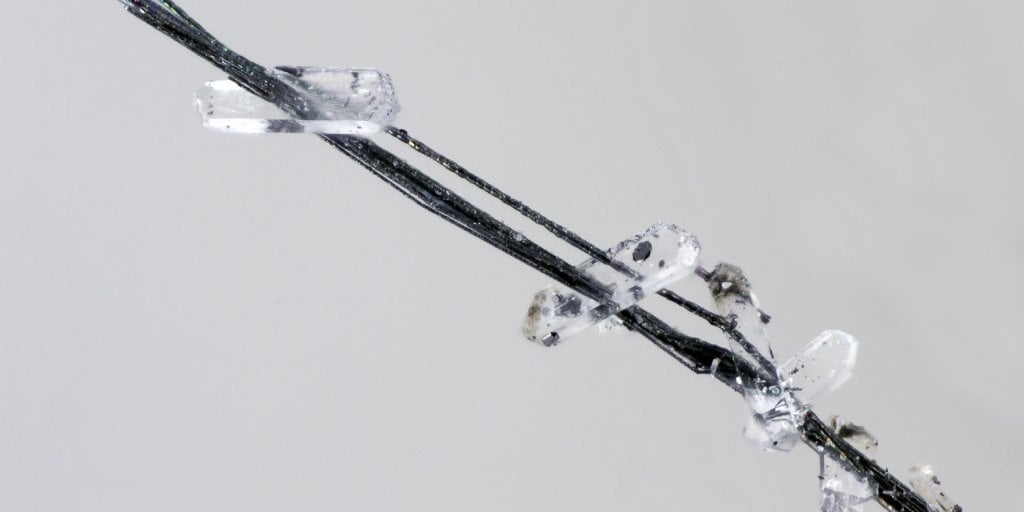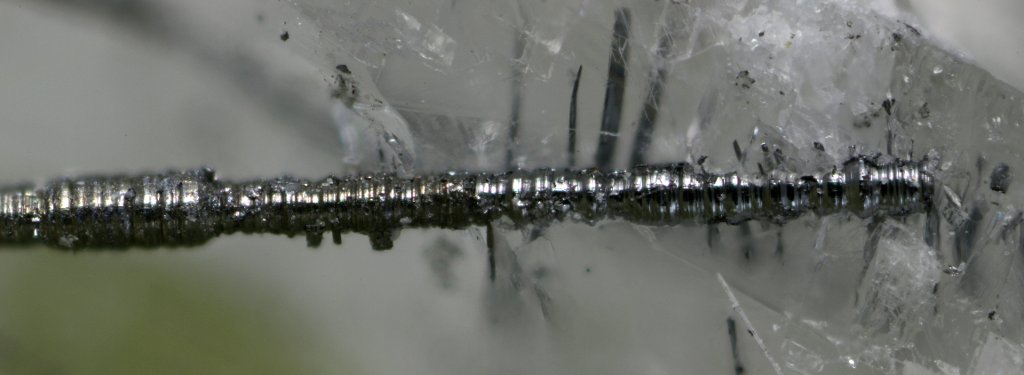Named for the region in Tanzania where it comes from, the International Mineralogical Association has declared merelaniite Mineral of the Year for 2016.
The mineral was first noted by a teenage student and her father working with a Smithsonian mineralogist; to prove the mineral was truly new, an international team of scientists put the samples through a battery of tests.
The team includes John Jaszczak, a professor of physics at Michigan Technological University, Mike Rumsey, senior curator at the Natural History Museum in London, Luca Bindi, a professor at the Universita? di Firenze in Italy, Michael Wise of the Smithsonian Institution and others. Together they unraveled the mysterious layers that make up merelaniite's unique structure.
Structure and Composition
Detailed chemical and physical analyses of merelaniite—a member of the cylindrite group—revealed a neatly stacked layered structure with sheets rolled in scrolls like tobacco in a cigar. These tiny whiskers, which to the naked eye look like very fine hairs nested on other larger crystals, have probably been often overlooked and even regularly cleaned off their host rocks containing other more recognizable minerals that occur at the famous gem mines near Merelani, Tanzania.

"Some minerals can have a natural wow factor, and while we use many of them daily without thinking twice, some specimens are truly objects of art," Jaszczak says, adding that minerals like the gems tanzanite (a blue/purple variety of zoisite) and tsavorite (a green variety of grossular garnet), which come from the same mines as merelaniite, can be more eye-catching. But it doesn't negate the value of less showy minerals.
“Minerals also have an internal beauty in their crystal structures and in the way that the structures influence their properties,” he explains. “Learning about minerals with unique crystal structures grants insight into the nature of matter, and sometimes inspires new human-made materials."
Mystery Mineral
Rumsey says that as soon as merelaniite came to his attention as an unknown material, he just knew the mineral and its structure would be exceptional.
"When you curate of one of the world’s finest and largest mineral collections, full of exotic specimens formed from nature’s grand chemistry set, you get to see a lot of unusual things," he says. "These little ‘whiskers’ in the rocks, along with all the beautiful associated minerals, told us we were potentially onto something exciting."
Because of the intricate layering and chemical complexity of merelaniite, Rumsey and Jaszczak had their work cut out for them to gather more detailed chemical, optical and spectroscopic analyses across the mineral samples.
“It is one thing to find a mineral that is probably new; it is quite another thing to be able to perform all of the required analyses to satisfy the Commission on New Minerals, Nomenclature and Classification for approval of its status and a new name,” Jaszczak says.
The results were promising, but not clear cut. So they took their mineral-in-the-rough data to Bindi, an expert in x-ray crystallography and unusual crystal structures.
“When Mike and John asked for my help to decipher the structure of merelaniite, I thought it was the same kind of request I usually get from colleagues working on new minerals. Well, I was wrong," Bindi says. "Merelaniite is really a masterpiece of structural complexity."

With Luca’s new x-ray data, the team realized that the complicated transmission electron diffraction patterns taken by collaborator Steve Hackney, a professor of materials science and engineering at Michigan Tech, meant that the mineral was a new member of the cylindrite group composed of alternating layers rolled up like filo dough. Like an intricate pastry, molybdenum disulfide layers alternate with lead sulfide layers, occasionally dotted with vanadium, antimony, bismuth, arsenic and selenium.
To top it off, the team was notified in June that merelaniite was selected by the International Mineralogical Association (IMA) as the 2016 Mineral of the Year. Sergey V. Krivovichev of the IMA says this annual initiative was started in 2014, and “recognizes a single new mineral species published in the previous year as most interesting and outstanding among others.”
Michigan Technological University is an R1 public research university founded in 1885 in Houghton, and is home to nearly 7,500 students from more than 60 countries around the world. Consistently ranked among the best universities in the country for return on investment, Michigan's flagship technological university offers more than 120 undergraduate and graduate degree programs in science and technology, engineering, computing, forestry, business, health professions, humanities, mathematics, social sciences, and the arts. The rural campus is situated just miles from Lake Superior in Michigan's Upper Peninsula, offering year-round opportunities for outdoor adventure.






Comments